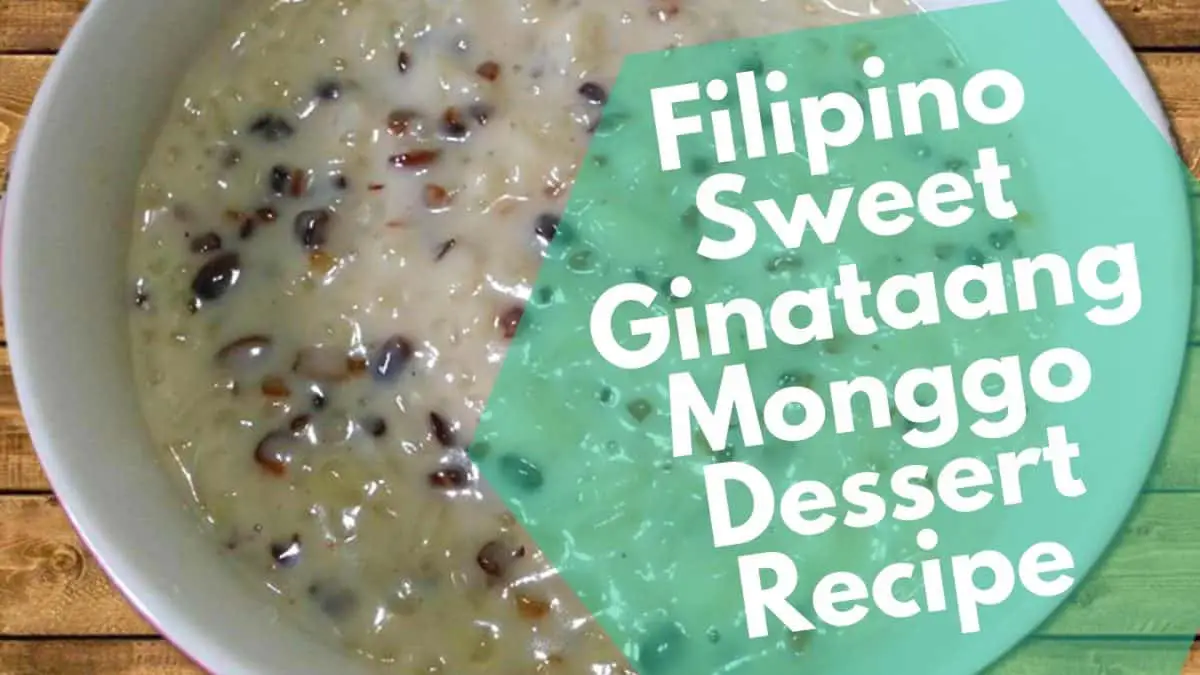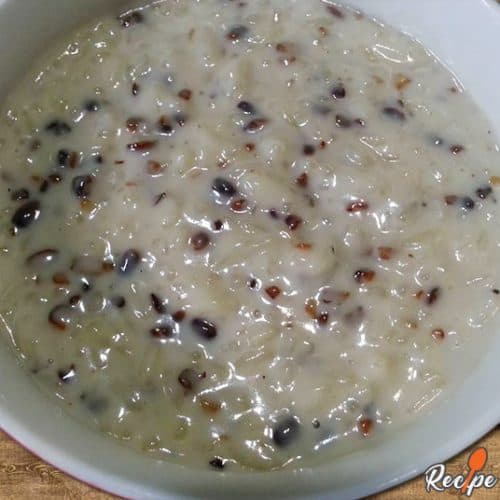Filipino sweet ginataang monggo dessert recipe that’s easy to make
Ginataang monggo is delicious but has so many variations you may not know what to look for.
The best ginataang monggo is on the sweeter side, making it the perfect snack. The right balance can even make it delicious when cold so we are going to use 1 can of coconut milk and just the right amount of vanilla in ours today.
This dish is relatively easy and quite simple to make, and at the same time, delicious!

This ginataang monggo is a Filipino dish. It’s a variation of ginataan, a dish with so many variations that may use meat, vegetables, or seafood as the main ingredient that’s then cooked in coconut milk.
Unlike most forms of ginataan, ginataang monggo is sweet, considered both a snack food and a dessert (if served cold), and quite similar to ginataang mais, as both are prepared in a similar manner, are snacks, and use a common ingredient: glutinous rice.

Check out our new cookbook
Bitemybun's family recipes with complete meal planner and recipe guide.
Try it out for free with Kindle Unlimited:
Read for freeIn this post we'll cover:
Ginataang monggo recipe preparation
To make ginataang monggo, you have to get the necessary ingredients, which are mung beans (monggo), coconut milk (ginataan), glutinous rice (kaning malagkit), and washed brown sugar.
Also, check this Pinoy macaroons recipe you can make at home
The first step in making this sweet and creamy dessert is to toast the mung beans. Put them over a fire, and toast until the beans are brown. Make sure that the beans are toasted well.
After toasting the mung beans, set them aside to cool down. Once cooled, use a mortar and pestle to crush the beans and set the crushed beans aside.
On a pan, cook the glutinous rice with some water. Stir to prevent the rice from burning in the pan.
Also, learn how to make these amazing old-fashioned ensaymada rolls
Once you’re done cooking the glutinous rice, put the monggo beans in, then coconut milk. Let it simmer.
You can add sugar to the ginataang monggo to add sweetness to the dish.
Once it has a thick consistency, you can now serve it in a bowl, either hot or cold, depending on the weather or how you want it to be. Eat it with your family or friends!

Ginataang monggo recipe
Ingredients
- ½ cup sticky rice (malagkit) washed
- ¼ cup mung beans (monggo)
- 1 cup water
- 1 can coconut milk
- ¾ cup sugar
- 1 cup corn kernels (optional)
- 1 tsp vanilla extract (optional)
Instructions
- In a pan, toast monggo until roasted and brown.
- Crush the monggo using a rolling pin or bottle, or a mortar and pestle. Set aside.
- In a casserole, mix the rice, roasted monggo, water, and coconut milk.
- Cook on low heat until the coconut milk is almost absorbed. Stir occasionally.
- Add the sugar, and optionally, the corn kernels and vanilla extract, and stir well. Remove from heat.
- Transfer to serving bowl and serve hot!
Video
Also check out this homemade kutsinta Filipino dessert recipe
Cooking tips
How are you finding out the ginataang munggo or monggo dessert recipe so far? It’s just easy, right?
However, the cooking process can be delicate, and therefore you need to take care of some cooking procedures so as not to overdo it.
Simply follow some of my cooking tips below to make your ginataang monggo a blasting party in your mouth at first taste!
- Mung beans should be cooked in the coconut milk for roughly 10 to 15 minutes before the malagkit to give them a head start because they take longer to tenderize than sticky rice.
- To impart a nutty flavor, toast the mung beans on a dry skillet. To slightly break the beans, use a mortar and pestle or place them in a plastic bag and pound with the back of a knife.
- To prevent burning the mixture or have it sticking to the bottom of the pot, do not leave it unattended for extended periods of time, and stir the mixture frequently.
- Before adding the sugar, make sure the sticky rice and mung beans have swelled and softened. If the sugar is added too soon, the rice may cook unevenly.
Again, this yummy Filipino dessert is best enjoyed when hot, but you can also do so when it’s cold. Whichever way you prefer, be sure that you’ll be satisfied after finishing a bowl!
Substitutes and variations
If you don’t have all the ingredients available in your kitchen, check out some of these ingredient substitutes and variations.
Using jasmine rice instead of sticky rice
Glutinous rice can be easily replaced with jasmine rice. This variety of rice will give your food the same gooey feel that glutinous rice would.
It can be used in congee, fried rice, or steamed dumplings, among other Asian dishes.
Using canned coconut cream or milk instead of fresh coconut cream
I personally encourage you to use fresh coconut cream or milk in making this Filipino ginataang monggo recipe for the best results, but if you can’t find one, canned coconut cream will do.
Note that the taste may not be the one you’re expecting when using canned coconut milk. So, if you have much time, it’s better to find coconut milk.
But I believe that it will be just an easy task if you are in the Philippines because they are a coconut-rich country.
There you have them! Don’t worry about the other ingredients as you can easily find them in any Philippine or Asian market.
How to serve and eat
Just like cooking this delectable dessert, serving and eating it also comes easy.
There’s no need to sweat it up because all it takes will be a spoon to scoop it from the bowl and enjoy.
Don’t forget to add some additional coconut cream on top for extra creaminess! You can also add a sprinkle of chocolates, peanuts, or even some raisins.
You can be as creative as you like with your ginataang munggo dessert!
How to store leftovers
In storing ginataang munggo leftovers, simply transfer leftovers into a container with a tight-fitting cover after they have totally cooled. Refrigerate for up to three days.
When eating it again, add a little water or coconut milk to soften the consistency when reheating.
Similar dishes
Can’t get enough of our ginataan dessert? Check out some of its similar dishes that are equally delectable!
Ginataang mais
Ginataang mais is rice and sweet corn porridge from the Philippines. Another name for it is lugaw na mais. It is a type of ginataan and lugaw dessert.
It can be consumed cold during the summer or warm during the colder months. Ginataang mais is Filipino for “corn with coconut milk.”
Ginataang halo-halo
Ginataang halo-halo is made of sticky rice balls simmered in coconut milk. Throughout the year, it is often consumed as a snack, dessert, or breakfast.
During the Lenten season, when Catholics typically fast and avoid eating meat, it is also a standard dish.
Binignit
Binignit is native to the Visayas. The meal is typically prepared with glutinous rice cooked in coconut milk together with various slices of taro, sweet potato, and sabá bananas.
Like ginataang halo-halo or bilo-bilo, which are popular in Metro Manila, binignit is also eaten during the Lenten season.
Try these desserts on your next ginataan cooking spree and you’ll never be disappointed!
Get your own bowl of ginataang monggo dessert today!
Don’t miss the chance to get a taste of this flavorful ginataang monggo! Head out to your kitchen now and start cooking this dessert.
Simply gather all the ingredients, follow my cooking procedures and tips, and if you don’t have all the ingredients, check out my ingredient substitutes and variations above.
Ace your ginataang monggo the first time!
Check out our new cookbook
Bitemybun's family recipes with complete meal planner and recipe guide.
Try it out for free with Kindle Unlimited:
Read for freeJoost Nusselder, the founder of Bite My Bun is a content marketer, dad and loves trying out new food with Japanese food at the heart of his passion, and together with his team he's been creating in-depth blog articles since 2016 to help loyal readers with recipes and cooking tips.
